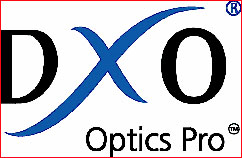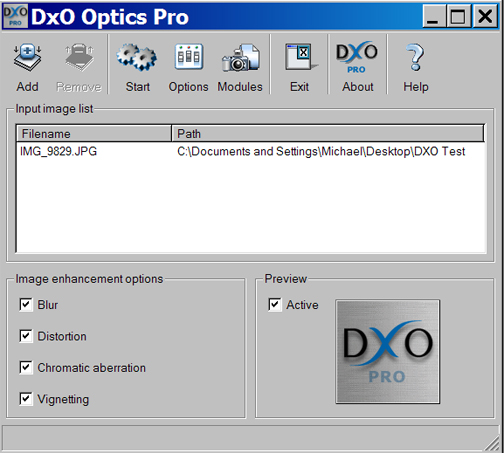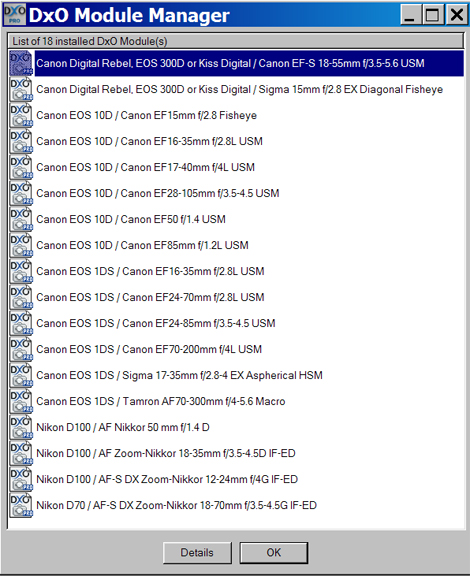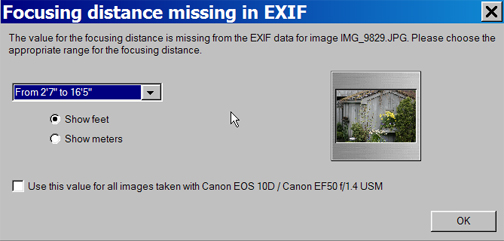
This Review First Published — May 11, 2004
Disclosure:I have been a beta tester ofDxO Optics Pro
and have consulted withDO Labson the development of this product.
I have no financial relationship with the company.
______________________________________________
What Is It?
First, I should explain what it’s not. This is notDxO Analyzer, a product that you may have read about previously on these pages, which is a professional optical test system designed byDO Labsfor use by camera and lens makers, and also reviewers. I utilize that program in my digital camera and lens tests, and you can read more about ithere.
Optics Pro, the subject of this report, is a stand-alone program (PC and Mac) that allows images shot with specific digital cameras and lenses to be corrected for distortion, vignetting, blur (sharpness) and lateral chromatic aberration. It generated a great deal of excitement when it was first announced at the PMA show, and much speculation about how well it would work.
______________________________________________
How it Works
This isn’t magic. It’s science. Quite a bit of it fact.DO Labsis a Paris based company that specializes in the application of mathematics to image enhancement. For their professional test product,DxO Analyzer, they developed mathematical tools which could measure to a high degree of accuracy various optical characteristics of lenses and sensors. It didn’t take a rocket scientist (or mathematician) to figure out that if you can measure the errors in a system, using this information you might be able to correct them as well. This is in fact what DO Labs has done with Optics Pro.
______________________________________________
In Use

Figure 1
When run Optics Pro is very simply to use. TheAddbutton is used to load a file or series of files, or you can drag-and-drop files from any file browser window. These files currently need to be JPGs generated by the camera (not converted from RAW files), though RAW files will be supported directly before year’s end.
If you have the right camera and lens modules (more on this in a moment) all you have to do next is to pressStart. Files that you have loaded will be processed and transferred to the directory of your choice. You can simultaneously process images done with different camera bodies and different lenses, but of course you have to have purchased the necessary modules. No need to link modules to files — Optics Pro does this automatically. In Figure 2 below you can see a window showing the modules that are loaded on my test system. Most users will simply purchase a camera module and lens module appropriate for the equipment that they own and use.

Figure 2
The one bit of user intervention that may be needed is to tell the program the approximate distance at which the shot was taken. Optics Pro tries to extract this information from the file’s EXIF data, but not all cameras provide it. There are several default settings that can be used for this if you’re doing batch processing, but it is best to select a distance range manually for each image for optimum results.

Figure 3
When the single file or batch of files has been processed you have the choice of exiting the program or viewing the results. The viewer is handy because it allows you to see a before and after of the converted files, at any magnification. This is fun the first few times, but after the "new" has worn off you’ll likely simply move on to your image editing program.
______________________________________________
How Good Is It?
In a word — remarkable. I know that some readers who aren’t familiar with the fact that I’m often very critical of products, and am not afraid to say so in print, will think that I’m being hyperbolic. But I’m not. This product is revolutionary. It can’t turn a bad lens into a good lens, but it can make a mediocre lens a lot better, and a good lens can be raised up to being terrific. I’d hate to put a percentage to it since the level of improvement will vary depending on a great many variables, but I’d describe what I usually see as at least a 50% subjective improvement, if not more — and that’s a lot.
I must admit that the samples that you’ll see below are not as extensive and descriptive as I would have wished. Two reasons — the first is that I don’t shoot JPG. Over the past year I’ve shot probably 15,000 frames with some of the camera bodies and lenses that Optics Pro supports, but not a single one of them is anything other than RAW. So I have no decent JPG images to go back to. Secondly, between when I returned from a European trip and starting to work with the final version of the program, and then the announcement of the product and publication of this report on May 11th, I had only a few days, and these were frequently rainy, or I was tied up with other projects.
Enough excuses. In completing this review I did some shooting with a half dozen lenses and a Canon 10D, and remain as impressed with what Optics Pro can do as I was during beta testing.

Figure 5
Move Your Mouse Over the Image for Before and After Views
Please note that it appears that some browsers (mainly Netscape) have a bug
which prevents these roll-overs from displaying properly. You may wish to use
IE or another browser instead to view these properly.
Figure 5 above was taken with a Canon 15mm Rectangular Fisheye on a Canon 10D. Move your mouse over the image to see a before and after of what Optics Pro can do in terms of correcting distortion. Till now one would have to have bought an even more expensive program, such asImagealign,and done much manual work to produce linear results like this. With Optics Pro it takes just one mouse click to take the heavily barrel distorted images produced by a 15mm fisheye lens and output nice linear images. For anyone with a reduced frame DSLR a 15mm lens opens up the world of wide angle shooting, and for this reason DO labs has provided initial support for Canon’s 15mm rectangular fisheye as well as the Sigma 15mm in both Canon and Nikon mounts. (Both images above are straight from the camera, with no adjustments other than Optics Pro conversion).

Figure 6
Move Your Mouse Over the Image for Before and After Views
If all Optics Pro did was to correct for optical distortion in a lens it would be worthwhile. But as can be seen in Figure 6 above (roll your cursor over the image for before and after views), what DO Labs calls "Blur", or apparent sharpness, is also enhanced. Again, these images have had no sharpening or other adjustments applied in Photoshop. They are straight from the camera.

Figure 7
In Figure 7 above we have a frame taken with the Canon 85mm f/1.2 lens. This is shown just to give you a sense of the full image. Below in Figure 8 we see a 100% crop, again with no sharpening applied to either the before or after image.

Figure 8
Move Your Mouse Over the Image for Before and After Views
I could go on, and I’m sure other reviewers will. I’ll leave off here by saying that what I see is a dramatic improvement in several aspects of image quality, and no visible negative affects at all. Improvements are most noticeable when using lower quality lenses. But even with very fine (and expensive) lenses improvements are readily visible.
______________________________________________
Update
Since this review first appeared there has been discussion on at least one online Board that the example in Figure 8 above shows sharpening halos, and that therefore either I have lied, and have sharpened the image, or that Optics Pro has done so.
Firstly, it is now my policy not to reply to postings on certain Boards (other than my own of course). This is at the request in at least one case of the Board’s owner, though why falsehoods and slander should be allowed to continue without rebuttal escapes me.
In any event, here is what’s going on in this image: The files that Optics Pro has to work on are JPGs. Unlike RAW files JPGs have been sharpened. This sharpening has been done by the camera. That’s what digital cameras do to JPG files, and is one of the downsides of shooting JPG — you don’t get to set the appropriate level of sharpening for each frame and final image size, the camera does.
Also, all files which have USM applied have halos, though obviously some more than others. Halos are caused by edge contrast differences, which is what USM does — enhance edge contrast (know in film days as "accutance"). The standard approach to applying the right amount of USM visually is to increaseRadiusandAmountin proportion for a particular image so that halos begin to be visible at 100% magnification. If one does this properly then at any normal print size they will be invisible. Too much and the image is oversharpened. To little and the amount of sharpening will be inadequate.
With this as background, we now recall that Image #8 above is shown at 100%. Therefore halos are visible, because they were added by in-camera sharpening when the file was turned into a JPG. To criticize either me or Optics Pro because there are halos visible is to simply not understand the nature of how sharpening works. To state the obvious — at normal print sizes these halos are invisible. And, as for Optics Pro, while there may be visible changes to the image at 100% due to having to work with pre-sharpened files, at any normal print size these are simply not visible. A large number of highly reputable and experienced testers have shown this to be the case over many months of intense analysis.
Regrettably a lack of understanding of this topic is all too common. That’s why we see people critiquing 100% enlargements of other people pictures online and making all kinds of unfounded deductions. Here’s a statement to consider:Any digital image seen at 100% that is either from an in-camera JPG or from a RAW file which has had USM applied properly by the user will show halos. One therefore can not use 100% magnification images to form a reliable conclusion about real-world image quality.
______________________________________________
Only JPG — For Now
Note that I am hindered in publishing extensive sample images simply because I personally never shoot JPGs. I only work with RAW files and Optics Pro currently only works with JPGs. I see this as the program’s biggest current drawback. If you think about it, this is the product’s fundamental contradiction. Photographers who care about optimum image quality shoot RAW files whenever possible. They are clearly this product’s target market. But the program will only process JPG files for now.
DO Labs obviously appreciates the issue and is working hard to complete a version of the program that will work with RAW files. This is a non-trivial problem, because the file would have to be delinerarized, de-mosaiced, processed, and then reconverted back to the camera’s RAW format. But DO Labs says that they will be announcing a RAW version by Photokina in September, 2004. Stay tuned.
You should also keep in mind that the program can not handle JPG files that have been auto-rotated in camera. Turn off auto-rotation now if you plan on using Optics Pro in future.
______________________________________________
What it Costs
DxO Optics Pro comes in three pieces. You need theirCorrection Engine,Camera Body Correction Moduleand thirdly aLens Correction Module. This means that you buy just the pieces that you need, but can upgrade or add what else may be needed down the road.
For example, right now everyone needs an 8 Bit JPG Correction Engine. This sells for $49. You need as well a Camera Body Correction Engine Module, which ranges in price from $49 to $149, depending on the camera. 6MP Nikon and Canon camera are at the low end of the pricing scale while a Canon 1Ds model, for example, is priced at $149. Most lens modules cost $99, but the ones for the Canon and Nikon kit lenses (with non-full frame coverage) are priced at just $29.
So, for example, the three modules needed for a Canon Digital Rebel or Nikon D70 with a kit lens would be as low as $127, while a Canon 1Ds owner would pay close to $300 for the same thing. This is a pricing model that we’ve seen before. Phase One, for example, has used it with theirCapture Onesoftware, where essentially the same software has been seen priced between $100 and $500, depending on the camera model on whose files it will be used.
This will be seen as advantageous to those with low-end equipment and gouging by those with high-end gear. Such is life. Companies have to maximize their return on investment and this has been found before to be a viable marketing approach.
DO Labs has done several things right when it comes to their pricing and support policies. For example, when you resell your camera and lens you may transfer your license to the software to the new owner. In other words, the DxO Module becomes part of the hardware.
There are pricing breaks as well. For example, if you buy two lens modules the second one is discounted 20%. A third by 30%, and a fourth by 35%. If you buy a second camera module it is discounted 20%.
There is also a launch discount. Almost all modules are discounted by 25% until June 30th, 2004. This means that by combining all of these discounts a Nikon D100 owner could, for example, pay $274 for a Correction Module, Camera Module and three lens modules, rather than the regular price of $366.
You should check the DO Labs web sitewww.dxo.comfor full details and currently pricing.
______________________________________________
Which Cameras and Lenses it Works With
This is a moving target. At launch, in May, 2004, DSLRs from Canon and Nikon are supported. These include the Digital Rebel 300D, Nikon D70 and D100, and the Canon 10D and 1Ds. The Nikon D2h and Canon 1Ds MK II will be supported shortly.
Lenses currently (May, 2004) supported are shown below. DO Labs says that they intend on launching support for some 200 lenses during 2004, and will be doing so on a monthly basis. Checktheir web sitefor updates.
Lenses Supported as of May, 2004
Canon EOS 10D Canon 16-35 ‘L’ f/2.8
Canon 17-40 ‘L’ f/4.0
Canon 85 f/1.2
Canon 24-70 ‘L’ f/2.8
Canon 28-105 f/3.5-4.5
Canon 50 f/1.4
Canon 15mm Fish-eyeCanon Digital Rebel / 300D / Kiss Digital Canon 18-55 Kit Lens
Canon 50 f/1.4
Sigma 15mm Fish-eye in Canon mountNikon D100 Nikkor 18-35 ‘AF’ f/3.5-4.5
Nikkor Zoom 12-24mm f/4 DX
Nikkor 50 f/1.4 D
Nikkor 85 f/1.4
Nikkor Zoom 24-85mm f/2.8-4D AFNikon D70 Nikkor 18-70 f/3.5 Kit
Nikkor 50 f/1.4 D
Sigma 15mm Fish-eye in Nikon mountComing this summer:
Nikon D2H With popular lenses
Canon 1D Mark II With popular lenses
Canon 1Ds With popular lenses
______________________________________________
Annoyances
There isn’t much to complain about. It’s annoying that the Viewer, which is available after each conversion (and which does a very nice job) can’t be accessed in any other way. In other words you can’t load the Viewer on its own so as to be able to look at somebeforeandaftercomparisons. The files have to be loaded into Photoshop or some other program to be able to do such comparisons. Beyond this, the program simply does what it’s intended to do.
______________________________________________
What’s Not to Like?
DxO Optics Pro is an impressive product, and given what it does the price / performance ratio is attractive. For anyone using a consumer-grade lenses, an extra one or two hundred dollars spent on Optics Pro will elevate the image quality produced to close to that of a much more expensive lens. Of course anyone with one of these expensive lenses can also buy Optics Pro and move their image quality up to an even higher level, so it’s a mugs game to think that this is the holy grail of photography. But it works, it works well, and its not unreasonably priced for what it does.
Some people might be mislead by the simplicity of the program’s interface. Unlike some software which presents you with a myriad of user controls and variables, Optics Pro simply lets you load files and process them. There are a few file handling options, and that’s it. But behind the scenes this program is performing some truly awesome math, and while it can’t turn a sow’s ear into a silk purse, it can noticeably improve several aspects of a lens’ image quality.
As I’ve already commented, my main beef with Optics Pro is that it only works with JPG files. On a personal level this means that the program is of no use to me, since I never shoot JPG. But for anyone that does, I can recommend the program without reservation. It does what it says it will. It does it very well, and it appears not to create any processing artifacts. You get visible improvements to your images, and nothing else.
When a module that supports RAW files comes out this Fall I’ll be the first in line to buy it.
You can find out more and purchase Optics Pro modules online atwww.dxo.com. It begins shipping on May 24th, 2004.
______________________________________________
Update:June, 2004
The following letter was received from a reader, which will be of interest to anyone using a Mac OS X system.
Hi,
I read your article about DxO Optics Pro. I purchased the software for
my Digital Rebel.I think that’s it’s very important to inform your readers that, with a
Macintosh computer, the pictures MUST NOT be dowloaded with the Image
Capture software from Mac OS X. Image Capture modifies the EXIF data
("QuickTime 6.5.1" is added in the software field) and then the
pictures can’t be processed by DxO. It will be corrected in the July
update (all info from DO Labs technical support). All my pictures were
imported in the Mac with Image Capture and ereased from the CF card,
therefore now I can use DxO only with new pictures (downloaded with a
USB CF reader).
______________________________________________
